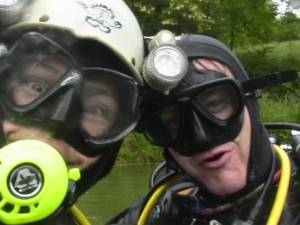
The north-east of France is unlikely cave country. It is fairly flat, agricultural land, dry and dusty, nothing like the great karst areas of the Lot, Herault or Ardeche. But it contains hundreds of caves and springs but only a handful of divers ever visit it. It is only five hours drive from Calais and very close for divers in Belgium, Holland and Germany.

| Our
main objective was to examine the end of the Douix de Chatillon cave in
the little market town of Chatillon-sur-Seine. The cave is shallow, only
270m long and has extremely good conditions year round. It is a common
training site for many French divers because of this. The cave itself ends
in a boulder choke and little progress has been made for many years. At
one point the cave was pumped until empty and examined by dry cavers, which
must have been hard work as it is far easier to do while underwater.
Our first dive in the Douix de Chatillon could have gone better. We both dived in our normal equipment for caves, I was using twin 20litre bottles and Jerome was using his Mk15.5 rebreather. We struggled through the first restriction because even though there was no noticeable flow in the main cave, the restriction channelled it and made it extremely hard to get through. The second restriction was even smaller, the length of the twin 20's made it hard to follow the passage into a tight right hand bend and the height of the Mk15.5 meant it was impossible for it to pass. I continued on alone only to scare myself at how much air I had lost from a small first stage leak so I turned. |
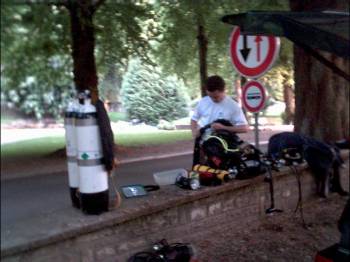 |
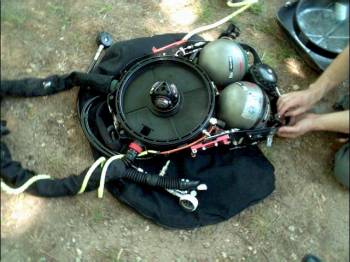 We
didn't fare much better the next day. Jerome had a complete failure of
every light he was carrying and only made it out of the cave by using the
back-light from his VR3. I managed to get 5-7m further on into the choke
but the way on was sidemount and very unstable. We
didn't fare much better the next day. Jerome had a complete failure of
every light he was carrying and only made it out of the cave by using the
back-light from his VR3. I managed to get 5-7m further on into the choke
but the way on was sidemount and very unstable. |
|
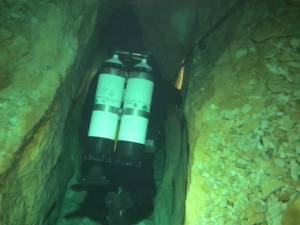 This
is the entrance to Douix de Chatillon. This
is the entrance to Douix de Chatillon. |
|
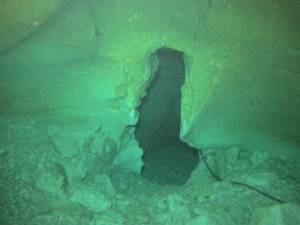 The
first restriction does not look too bad but a 4m x 4m wide passage with
a slight flow narrows into something a body width across then it becomes
quite a challenge. The
first restriction does not look too bad but a 4m x 4m wide passage with
a slight flow narrows into something a body width across then it becomes
quite a challenge.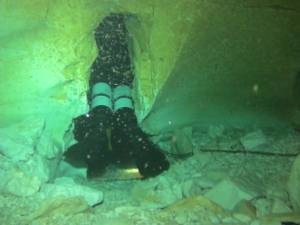 |
|
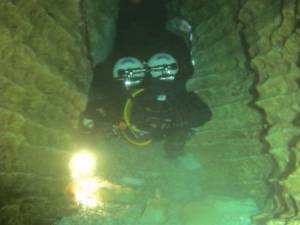 Passing
through one of the stranger parts of the cave Passing
through one of the stranger parts of the cave |
|
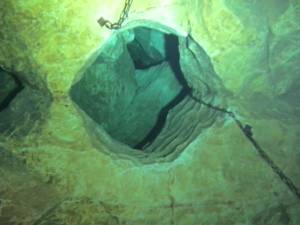 The
second restriction and coming out of it on the other side. The
second restriction and coming out of it on the other side.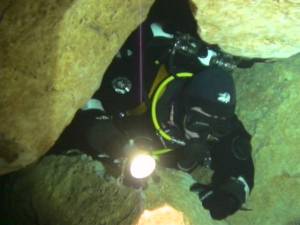 |
|
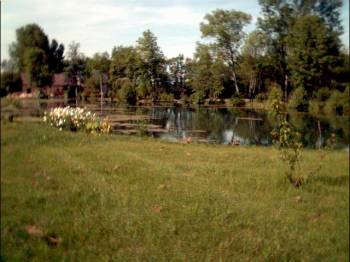 We
drove past the Fosse Dionne, an amazing pool in the town of Tonerre, resolving
to return and dive it. There were no signs to ban divers and the pool is
on public land. There was also no sign of it being pumped for drinking
water. After looking at it we drove further south to look for a few other
caves. We located the Source de la Moulin Blanc but the owner was not around
so we left it for another time. On the way to find some other sites, we
noticed a sign to a park with the word "sources" in big letters. A quick
investigation, involving driving through a river, identified three springs
which could be dived in small bottles. They had not been dived before,
there was a considerable amount of water coming out and the water was crystal
clear. Another one for another day. We
drove past the Fosse Dionne, an amazing pool in the town of Tonerre, resolving
to return and dive it. There were no signs to ban divers and the pool is
on public land. There was also no sign of it being pumped for drinking
water. After looking at it we drove further south to look for a few other
caves. We located the Source de la Moulin Blanc but the owner was not around
so we left it for another time. On the way to find some other sites, we
noticed a sign to a park with the word "sources" in big letters. A quick
investigation, involving driving through a river, identified three springs
which could be dived in small bottles. They had not been dived before,
there was a considerable amount of water coming out and the water was crystal
clear. Another one for another day.
On the way home we stopped at Fosse Dionne again. It was late, it had been a long day and we managed to persuade ourselves it wasn't the right time. |
|
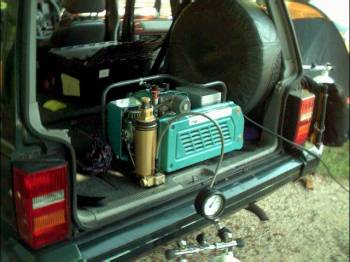 An
electric compressor, what every new Jeep now comes equipped with... An
electric compressor, what every new Jeep now comes equipped with... |
|
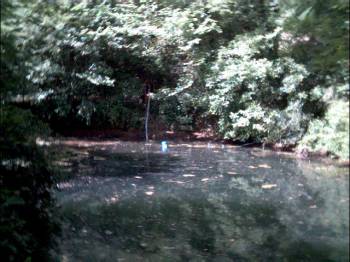 Next
day we went to Creux Janin, a small pool in a valley near Beze. I had visited
it last year, and like then, the visibility was still poor. Jerome dived
first to locate the entrance but could not pass on his rebreather also
suffering a damaged gauge. Next
day we went to Creux Janin, a small pool in a valley near Beze. I had visited
it last year, and like then, the visibility was still poor. Jerome dived
first to locate the entrance but could not pass on his rebreather also
suffering a damaged gauge. 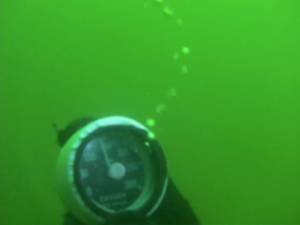
I tried in sidemounts
but by this point the visibility was nil. |
|
| Another site we found was the Trou Jalleu. This is a u-shaped pit in a field near Gray, it descends straight down into a room, passes a restriction and rises again in another passage on the other side. It looked promising as no-one had located the way on. We obtained permission from the owner and prepared to dive. It is a bright blue pool of water in a hay meadow, the entry is a long slot in the bottom of the pool. The shaft is full of debris which is easily disturbed and despite the good visibility, the piles of organic matter are easily disturbed. We reached the room at the bottom, I filmed Jerome swim into the narrow passage and then had a good look for other leads in the main room. Our plans to then investigate the sumps of Combe aux Pretres was cancelled by a massive thunderstorm. | |
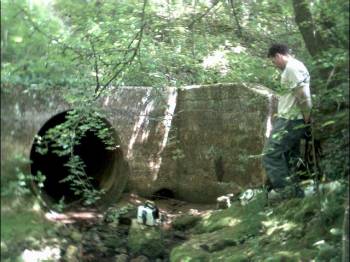 Our
drive back home north the next day took us through Haute Marne. This is
a very different region to Cote d'Or and Yonne, almost alpine. We planned
to investigate two sites, the Cul du Cerf and the Source de la Bezerne.
Cul du Cerf looked an interesting site on the map, it turned out to be
a massive crater caused by a cave collapse. Getting ourselves never mind
any equipment to the cave looked quite time consuming so we passed. We
went instead to the Source de la Bezerne. It took a bit of searching to
find as the site is no longer there. A road has been built over it but
it can still be accessed by following a culvert beneath the bank of the
road which leads to an artificial chamber where the spring pool is. The
visibility is extremely good but it is a sustained sidemount dive and the
return is usually done in nil. Our
drive back home north the next day took us through Haute Marne. This is
a very different region to Cote d'Or and Yonne, almost alpine. We planned
to investigate two sites, the Cul du Cerf and the Source de la Bezerne.
Cul du Cerf looked an interesting site on the map, it turned out to be
a massive crater caused by a cave collapse. Getting ourselves never mind
any equipment to the cave looked quite time consuming so we passed. We
went instead to the Source de la Bezerne. It took a bit of searching to
find as the site is no longer there. A road has been built over it but
it can still be accessed by following a culvert beneath the bank of the
road which leads to an artificial chamber where the spring pool is. The
visibility is extremely good but it is a sustained sidemount dive and the
return is usually done in nil.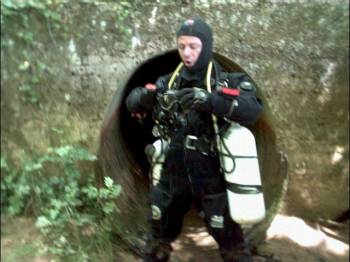 |
|